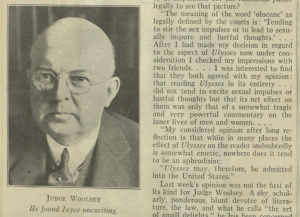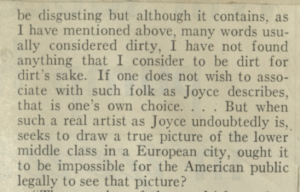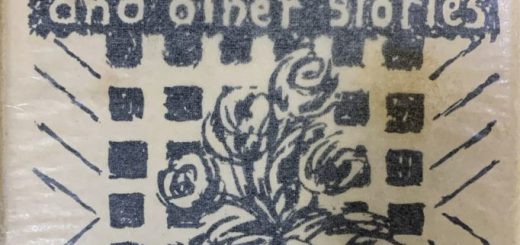Judge Woolsey: He Found Joyce Unexciting by Jessica S.


Many of the articles in the collection, “Clippings and articles on James Joyce,” focus on the American interpretation of Joyce’s Irish story, Ulysses. One article that stood out to me, “A Welcome to Ulysses,” discussed the obscenity case against Joyce’s novel. The novel takes place over the course of a single day in working class Dublin. It was considered obscene for its vulgar language and depiction of sex.
In describing the case, the author focuses at length on the case’s Judge, John Woolsey. He decided that the book was not overly obscene, even if it did seem to be “disgusting” at points. Woolsey wrote that: “If one does not wish to associate with such folk as Joyce describes, that is one’s own choice…But when such a real artist as Joyce undoubtedly is, seeks to draw a true picture of the lower middle class in a European city, ought it to be impossible for the American public legally to see that picture?” This question of access was particularly important at a time when European travel was inaccessible to the lower middle-class American. Literature would have been one of the primary ways Americans could learn about other cultures and nations.
These articles stood out to me because they highlighted the differences between art and government. I was fascinated by the way the articles focused on the presumably more boring judicial case, rather than the supposedly obscene novel. It would be interesting to see whether American courts (and the attention newspapers paid to the art) would change with a case about, for example, a supposedly lurid painting or photograph. These portrayals represent a moment, rather than a narrative, so would likely be seen as less able to portray lower-class Irish life in a way that was acceptable to the American public and its courts. This raises the question of whether there is something particularly distinct about how books portray both potentially scandalous material and enriching cultural material that is different from visual or auditory mediums.
It also made me think about the way information, especially art, was consumed in Joyce and Woolsey’s time. In today’s age of internet, it seems unlikely that Woolsey’s cultural enrichment argument would still stand. Today, working class Americans do not need to rely on literature to learn about other cultures. The internet serves to globalize perspectives and allow people to tell their own stories. It almost seems more likely that Woolsey’s argument – that some vulgarity is worth educational potential – is now a more suitable defense for the internet itself than for Joyce’s book.
Ulysses is not Joyce’s only work to focus on areas of Dublin that are not elite or sophisticated. For example, the story “Counterparts” in Dubliners shows an evening spent by a working-class man named Farrington. His feels degraded by his work, his boss, and his lack of money. He drinks with his friends but feels humiliated and loses what little money he has. He goes home and beats his child. This story would be familiar to many working-class Americans but provides a uniquely Irish context through descriptions of work, recreation, and familial practices. When Farrington is beating his son, the boy says “I’ll say a Hail Mary for you.” This highlights the religious difference between Ireland, a largely Catholic nation, and America, which was mostly Protestant. Joyce’s focus on the working-class Irish provided an opportunity to expand the American worldview, even as he showed how they were similar.
I also found the juxtaposition of Woolsey and Joyce interesting because they highlighted how Americans made this book about themselves. In one article in this collection, he is described as “once a moody, poetic, sex-and-religion tortured young Irishman…now a nervous, ill, half-blind recluse.” In “A Welcome to Ulysses,” the only mentions of Joyce’s personal attributes are his upcoming eye operation and financial troubles. On the other hand, it focuses extensively on the personal characteristics of the judge. Multiple articles have pictures of Woolsey, and none have pictures of Joyce. Despite his focus on the working class, Woolsey embodied the American elite of his time, having been educated at schools like Phillips Andover and Yale. Woolsey is described as “Fat, bald-headed,” and “a shy, scholarly, ponderous, blunt devotee of literature, the law, and what he calls the ‘art of small delights.” The article describes at length his previous cases and hobbies, of which the author writes: “He collects pipes, strangely blended tobaccos, old clocks. He plays mediocre golf, wearing a peculiar oriental cap…” This contrast between the minute details of Woolsey’s personal life and the total lack of detail about Joyce reflects how Americans care more about an average American judge than a renowned, if reduced, Irish author.
These competing portrayals of Joyce and Judge Woolsey highlight the American perspective on Joyce’s novel and the obscenity case. Joyce, who could be considered obscene for having written something seemingly obscene, is deemed irrelevant. His art is seen as separate from himself and he is viewed as an invalid in need of money. This highlighted how Americans valued the opinions of other Americans more than the authors whose works were being evaluated. Joyce, if mentioned, was discussed in the abstract. Much more focus was given to Judge Woolsey, whose contribution was to allow Joyce’s novel to exist in America. Even though the case was ruled to give Americans a perspective on the Irish, this article gave me more context to the American reception than Joyce himself.









Recent Comments